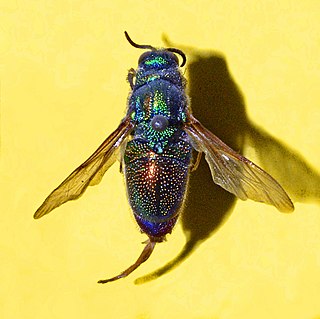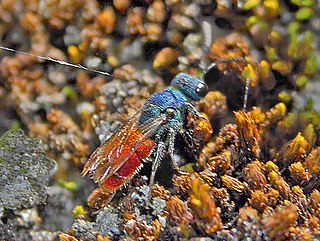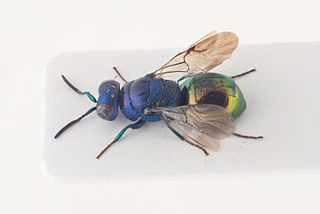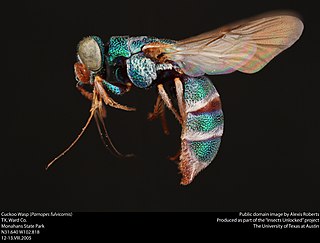
Andrey Petrovich Semyonov-Tyan-Shansky was a Russian entomologist specializing in beetles. He was the son of Pyotr Semyonov-Tyan-Shansky. He was among the first entomologists to consider the protection of insects and the risk of their extinction.

Commonly known as cuckoo wasps or emerald wasps, the hymenopteran family Chrysididae is a very large cosmopolitan group of parasitoid or kleptoparasitic wasps, often highly sculptured, with brilliant metallic colors created by structural coloration. They are most diverse in desert regions of the world, as they are typically associated with solitary bee and wasp species, which are also most diverse in such areas. Their brood parasitic lifestyle has led to the evolution of fascinating adaptations, including chemical mimicry of host odors by some species.
Nicrophorus przewalskii is a burying beetle described by Semenov-Tian-Shanskij in 1894.

Chrysis inaequalis is a species of cuckoo wasps. The species occurs in Central and Southern Europe and in the Near East. The head and the thorax are shiny metallic blue-green, while the abdomen is red. Adults grow up to 5–10 millimetres (0.20–0.39 in) long and can be encountered from late June to mid September, especially flying on sun-exposed walls, on rocks and on dead wood.

Hedychrum rutilans is a species of cuckoo wasps. The species occurs primarily in Austria, Italy, Bulgaria, Greece, France, Poland, Portugal, Spain, Switzerland and in North Africa. The head and thorax are metallic green with red spots, while the abdomen is red. The color is more green and partially golden in the male and more extensively golden-red in the female. The body is somewhat hairy.

Julodinae is a subfamily of beetles in the family Buprestidae, containing the following genera:

Clema is a genus of beetles in the family Buprestidae, containing the following species:

Stilbum cyanurum, is a large Old World species of cuckoo wasps.
Coptosia elyandti is a species of beetle in the family Cerambycidae. It was described by Semenov-Tian-Shanskij in 1891. It is known from Turkmenistan, Kyrgyzstan, Tajikistan, Kazakhstan, and Uzbekistan.
Josephine Christina Cardale worked as an entomologist for CSIRO from 1967 to 2001. She was a collection manager of Hymenoptera at the Australian National Insect Collection.

Parnopes is a genus of cuckoo wasps in the family Chrysididae. The known hosts are in the Crabronidae, subfamily Bembicinae.

Chrysura simplex is a species of cuckoo wasps, insects in the family Chrysididae.

Chrysis ruddii, the ruby-tailed wasp, is a species of cuckoo wasps, an insects in the family Chrysididae.

Trichrysis is a genus of cuckoo wasps, insects in the family Chrysididae.

Chrysis angustula is a species of cuckoo wasps, insects in the family Chrysididae.

Omalus aeneus is a species of cuckoo wasps belonging to the family Chrysididae.

Omalus biaccinctus is a species of cuckoo wasps belonging to the family Chrysididae.
Elampus is a genus of insects belonging to the family Chrysididae.

Parnopini is a small tribe of cuckoo wasps in the family Chrysididae. There are 3 genera and about 20 described species in Parnopini; only the hosts of one genus (Parnopes) are known, and they are in the Crabronidae.

Chrysis fulgida, the ruby-tailed wasp, is a species of cuckoo wasp in the family Chrysididae.















